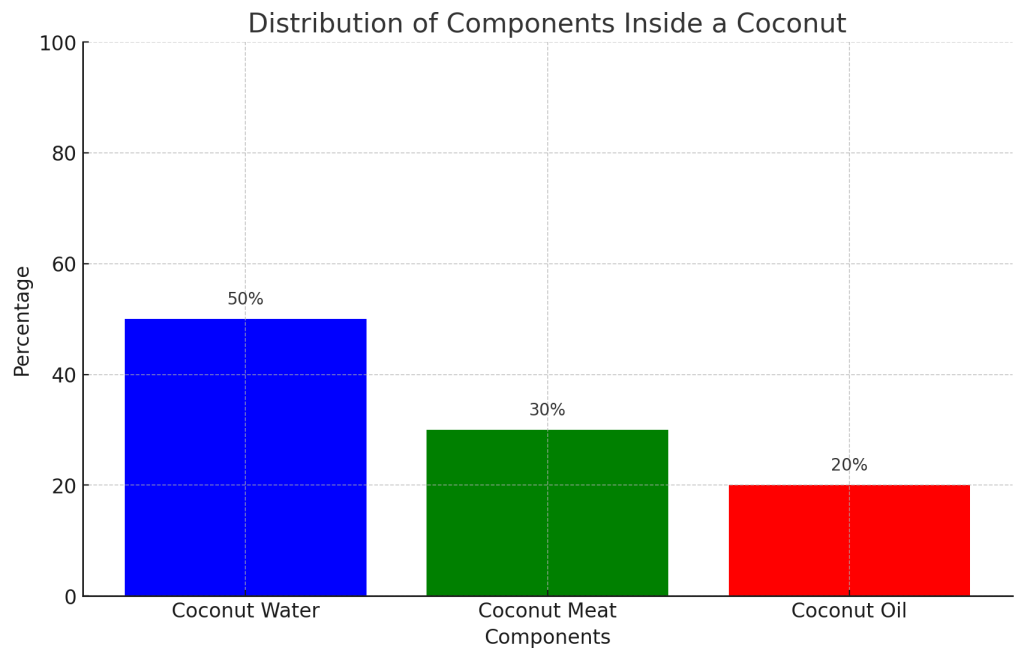Coconuts, the versatile fruits of the tropics, hold many secrets within their hard shells. This article delves into what the inside of a coconut looks like, unraveling the mysteries and marvels of this tropical delight.
The Anatomy of a Coconut
The Husk and Shell
The first layer of a coconut is its fibrous husk, which encases a hard, woody shell. This shell is the guardian of the coconut’s inner treasures.
The Coconut Meat
Upon cracking open the shell, you’re greeted with the white, fleshy coconut meat. This is the part most commonly consumed and used in various culinary preparations.
Coconut Water
Inside the meat is the coconut water, a refreshing and hydrating liquid, often enjoyed as a natural beverage. This water is different from coconut milk, which is derived from the meat.
Nutritional Profile of a Coconut’s Interior
Listed below are some of the key nutrients found in the inner components of a coconut:
- Hydration: Coconut water is rich in electrolytes like potassium and magnesium.
- Dietary Fiber: The meat provides a good source of dietary fiber.
- Healthy Fats: Coconut meat is high in medium-chain triglycerides, a type of beneficial fat.
Culinary Uses of Coconut’s Inner Parts
- Cooking and Baking: Coconut meat is used in various recipes, from savory dishes to desserts.
- Beverages: Coconut water serves as a refreshing drink, while coconut milk, made from the meat, is used in smoothies, curries, and more.
For more insights on the culinary versatility of coconuts, explore our article on “What Does Cream of Coconut Look Like?”.

The Lifecycle of a Coconut
Understanding the journey from a young, green coconut to a mature, brown one provides insights into the changes occurring inside a coconut. For a deeper dive, read our piece on “What Does a Ripe Coconut Look Like?”.
Coconut’s Role Beyond the Kitchen
Medicinal Uses
Coconuts have been used in traditional medicines, leveraging their antiviral and antibacterial properties.
Skincare
Coconut oil, derived from the meat, is renowned in skincare. However, it’s crucial to distinguish fresh oil from expired. Learn more at “What Does Expired Coconut Oil Look Like?”.
Environmental Impact
The coconut tree and its fruit are integral to many ecosystems. To understand their growth, visit “What Does a Coconut Tree Look Like?”.
The Lifecycle of a Coconut
Understanding the journey from a young, green coconut to a mature, brown one provides insights into the changes occurring inside a coconut. For a deeper dive, read our piece on “What Does a Ripe Coconut Look Like?”.
Coconut’s Role Beyond the Kitchen
Medicinal Uses
Coconuts have been used in traditional medicines, leveraging their antiviral and antibacterial properties.
Skincare
Coconut oil, derived from the meat, is renowned in skincare. However, it’s crucial to distinguish fresh oil from expired. Learn more at “What Does Expired Coconut Oil Look Like?”.
Environmental Impact
The coconut tree and its fruit are integral to many ecosystems. To understand their growth, visit “What Does a Coconut Tree Look Like?”.
Conclusion
The inside of a coconut is a world of nutrition, culinary potential, and natural wonder. Its components, from the refreshing water to the rich meat, offer a spectrum of uses that extend well beyond the kitchen.

